Key Points:
- Both German and Roman Rottweilers were initially bred in Germany. However, Roman Rottweilers were used as a herding breed by the Romans, hence the name.
- In general, Roman Rottweilers are a bit taller and heavier than German Rottweilers. Their short, thick hair can take on multiple color combinations, while German Rottweilers have short, straight, coarse hair that comes in color combos of black/mahogany, black/rust, or black/tan.
- German Rottweilers are highly intelligent and trainable dogs, often used as service dogs. Roman Rottweilers are clever and eager to learn but tend to be stubborn, so should be socialized and trained from a young age.
What distinguishes the Roman Rottweiler from the German Rottweiler? Is it the same dog? In short, the “Roman” Rottweiler is bred to be larger and heavier than the Rottweiler breed standard calls for. Now that we know that, let’s compare the Roman and German Rottweilers further. There are eight primary differences, which are separated into appearance, personality, and health factors. Let’s go!
Roman Rottweiler vs. German Rottweiler: A Comparison

| Category | Roman Rottweiler | German Rottweiler |
|---|---|---|
| Height | 24 – 30 inches | 24 – 27 inches |
| Weight | 85 to 130 lbs | 77 to 130 lbs |
| Coat type | Short, Thick | Short, Straight, Coarse |
| Colors | Multiple Color Combos | Black/Mahogany, Black/Rust, Black/Tan |
| Temperament | Independent, Courageous, Protective | Energetic, Obedient |
| Trainability | Difficult | Somewhat Difficult |
| Energy Levels | High | Very High |
| Health Problems | Joint Problems, Bone Conditions, Heart Issues | Cardiomyopathy, Von Willebrand’s Disease |
Key Differences Between Roman Rottweiler and German Rottweiler
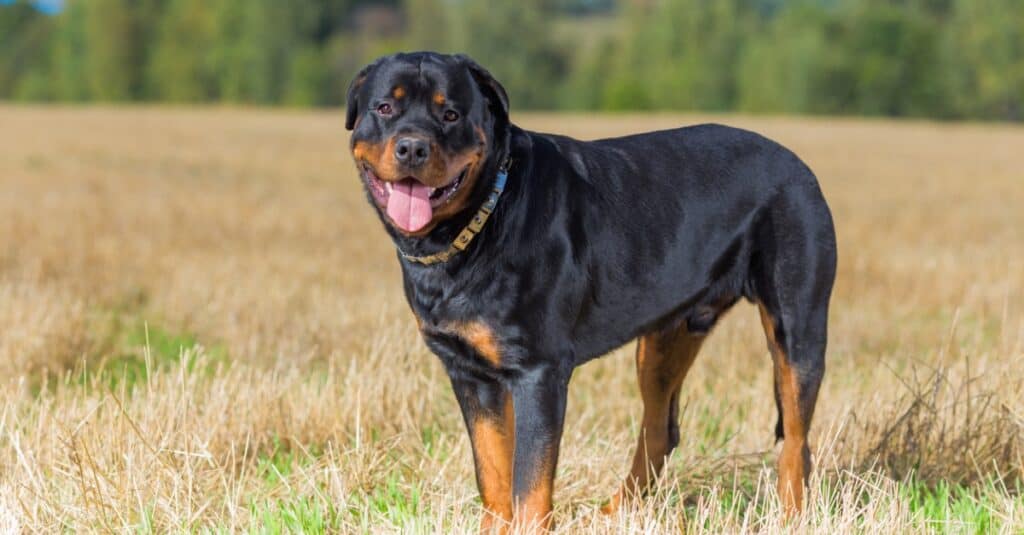
The Roman Rottweiler was originally bred with a Mastiff to herd livestock and pull carts.
©iStock.com/Ideas_Studio
There are differences between Roman Rottweilers and German Rottweilers, even if you may not be able to tell at first glance. There are three main Rottweiler breeds: American Rottweilers, German Rottweilers, and Roman Rottweilers. Roman Rottweilers are not a recognized breed of Rottweiler, but rather a “type.” In fact, the term “Roman” is misleading because these gigantic Mastiff-type canines were initially bred in Germany. All Rottweilers, even those bred in America, have German ancestry. The Roman Rottweiler is often a combination of a Mastiff and a Rottweiler. Originally, they were utilized as a herding breed by the Romans, hence the name “Roman” Rottweiler.
Appearance
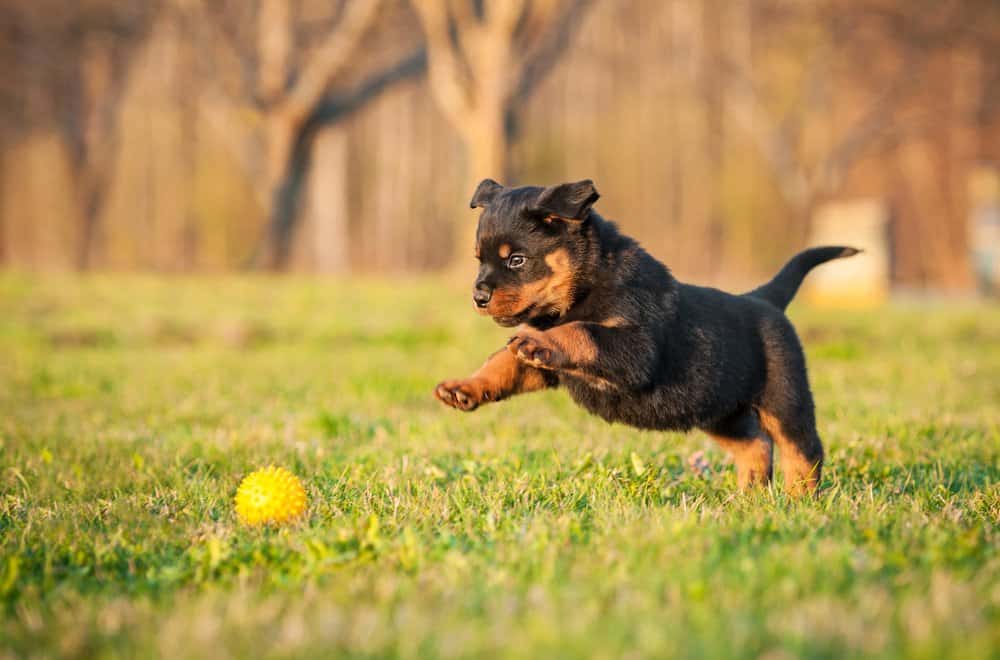
The German Rottweiler can grow to 27 inches and 130 pounds, while the Roman Rottweiler is larger on average.
©Rita_Kochmarjova/Shutterstock.com
Height
Male German Rottweilers can be up to 27 inches tall, and females can get up to 25 inches tall. Roman Rottweilers reach 22–25 inches and the males grow up to an average of 24–30 inches.
Weight
A Roman Rottweiler can weigh up to 95 pounds on average. Female Rottweilers are usually lighter than males. Weight ranges from 95 to 130 pounds for a male Roman Rottweiler and 85 to 115 pounds for a female.
With an adult male measuring 110-130 pounds and a female between 77 and 110 pounds, the German Rottweiler is another large-sized dog. The Roman Rottweiler, on the other hand, is bred to be larger than the average Rottweiler.
Traditionally, the tails of Rottweilers were docked to prevent injury in their roles as working dogs, doing jobs such as pulling carts or herding animals. In modern times, some owners have their Rottweilers’ tails docked for appearances or to compete in dog shows.
Whether you have a Roman or German Rottweiler we recommend choosing one of the best dog foods, especially for Rottweilers to support their large muscle mass, and healthy coat, and avoid chronic issues like flaky and dry skin.
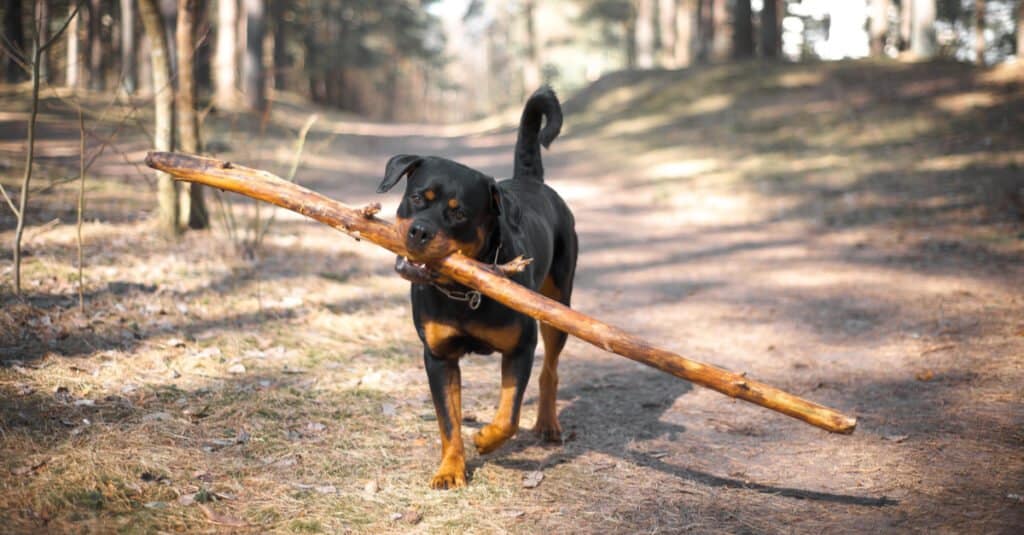
Roman Rottweilers are not an official breed of Rottweiler, while German Rottweilers originated the breed.
©Mariya Kuzema/Shutterstock.com
Coat Type
The short, straight, and coarse double coats of the Roman Rottweiler are distinctive. Undercoats are present on the neck and lower torso; the outer coat is medium length.
A top coat and an undercoat are present in German Rottweilers. However, the undercoat is fully hidden beneath a medium-length, rough topcoat. Rottweilers have thicker coats, but how much undercoat they have depends on where they live.
Colors
There are many different shades of black and tan Roman Rottweilers, as well as black and dark rust and black and mahogany. Additionally, red, blue, and black options are also available. The Roman Rottweiler can be found in a variety of other colors, although they are not considered desirable.
The German Rottweiler standards are exceedingly stringent in all aspects, including coat color. Black/Mahogany, Black/Rust, and Black/Tan are the most common and acceptable color combinations in German Rottweilers.
Characteristics
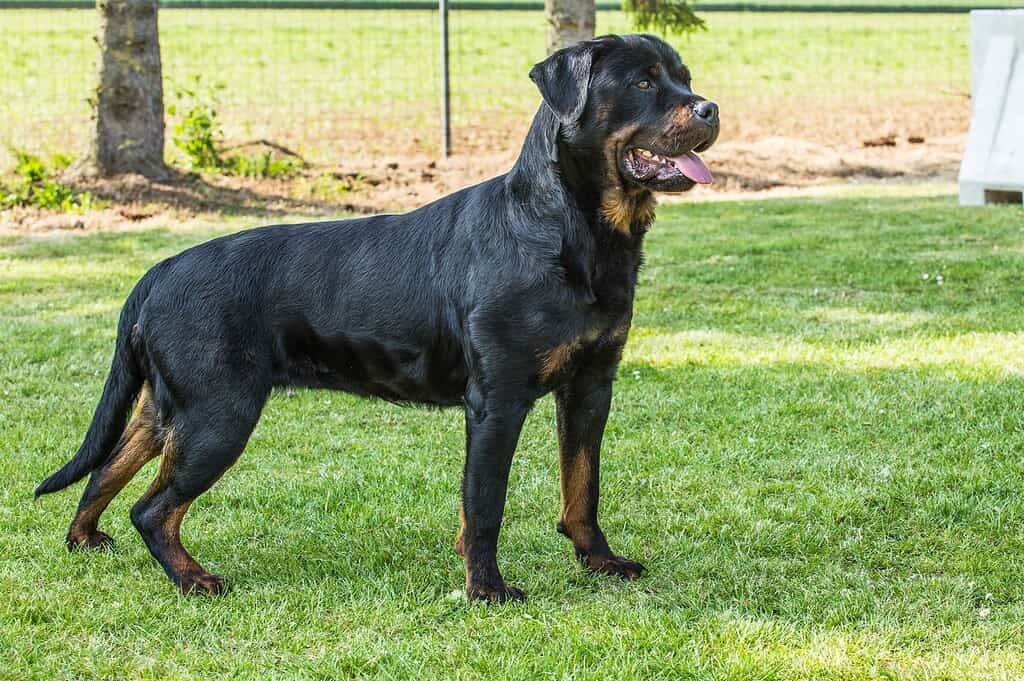
Roman Rottweilers often don’t have tails, while German Rottweilers have long and fluffy tails.
©iStock.com/Eric Metz
Temperament
To a degree, German Rottweilers and Romans have a lot of the same temperament characteristics. Protective, calm, sociable, intelligent, and watchful are some of the characteristics of Rottweilers. Rottweilers are on par with other dogs and their owners in terms of hostility. However, they are more hostile toward strangers than the typical dog. Also, Rottweilers are quite territorial.
The Roman Rottweiler is a loyal, faithful, obedient, and enthusiastic worker who has a mild demeanor. There is consistency and evenness in the dog’s temperament. These canines have been successful in police, military, and customs work because of their intelligence and strength.
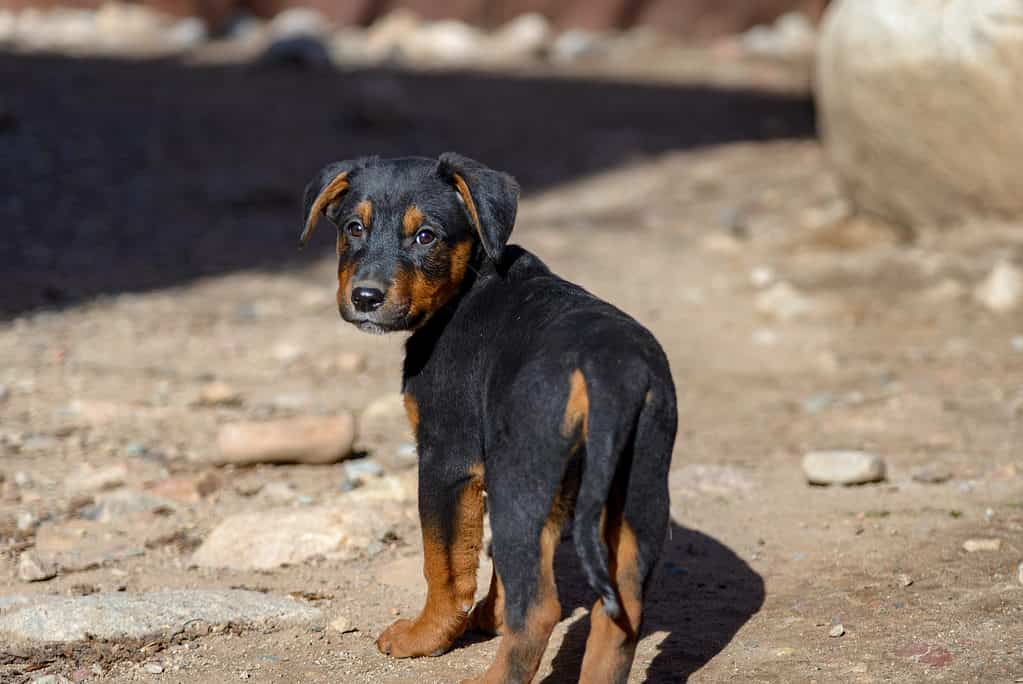
German Rotties are some of the most intelligent and trainable dogs in the world.
©Karen Sanders Studio/Shutterstock.com
Trainability
It’s imperative that Roman Rottweilers are properly socialized and trained from a young age. They are a breed of clever, eager-to-learn dogs, yet they can be stubborn at times. Trainers should conduct short and frequent training sessions to be most successful.
However, German Rottweilers are some of the most intelligent and trainable dogs in the world. They’re frequently employed as service and working dogs because of this. Even though many Rottweilers have a stubborn character, they’re rather straightforward to teach compared to other breeds.
Health Factors
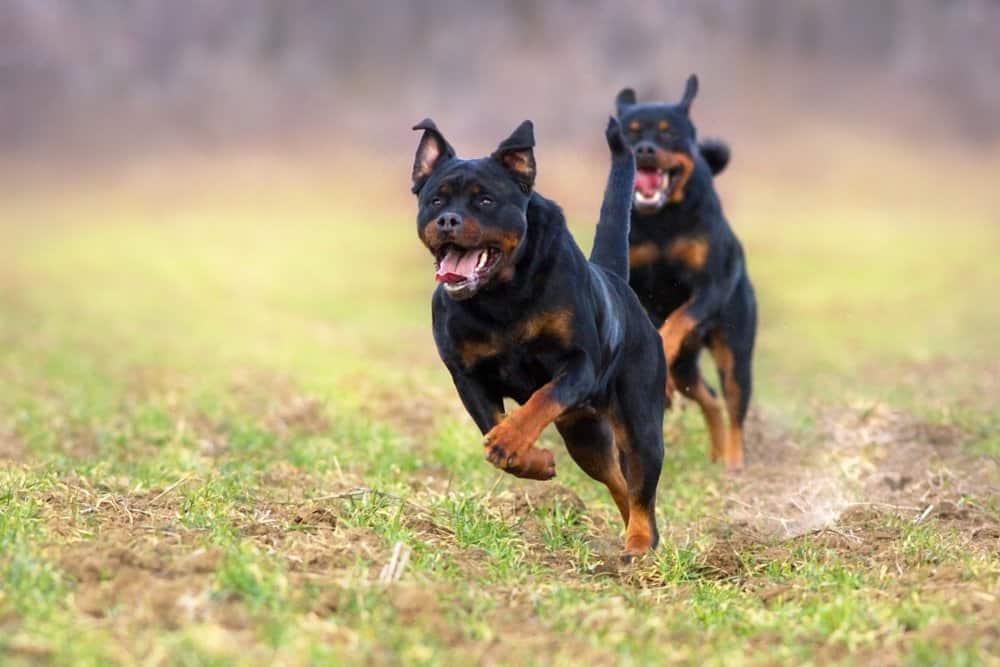
Roman Rottweilers tire faster on average than German Rottweilers.
©Callipso/Shutterstock.com
Health Problems
Certain breeders deliberately produce larger and heavier dogs than the breed standard requires. As a result, these breeds are more susceptible to disorders. They are also more susceptible to snoring and overheating. Roman Rottweilers commonly suffer from joint issues including hip dysplasia.
Cataracts, abnormalities of the eyelids, and other vision and eye disorders can occur in German Rottweilers. Additionally, Rottweilers develop cancer or inherit a cardiac problem in their older years as well.
Energy Levels
Rottweilers require two daily workouts due to their high energy levels. German Rottweilers benefit from running around the yard, taking brief morning walks, and going for a big walk at night. Additionally, the Roman Rottweiler is larger and often as energetic as the German Rottweiler. After a long, exhausting day of play, they tend to be more sluggish. However, they can also vary more in energy levels due to their mixed breeding history.
Wrapping up Roman Rottweiler vs. German Rottweiler
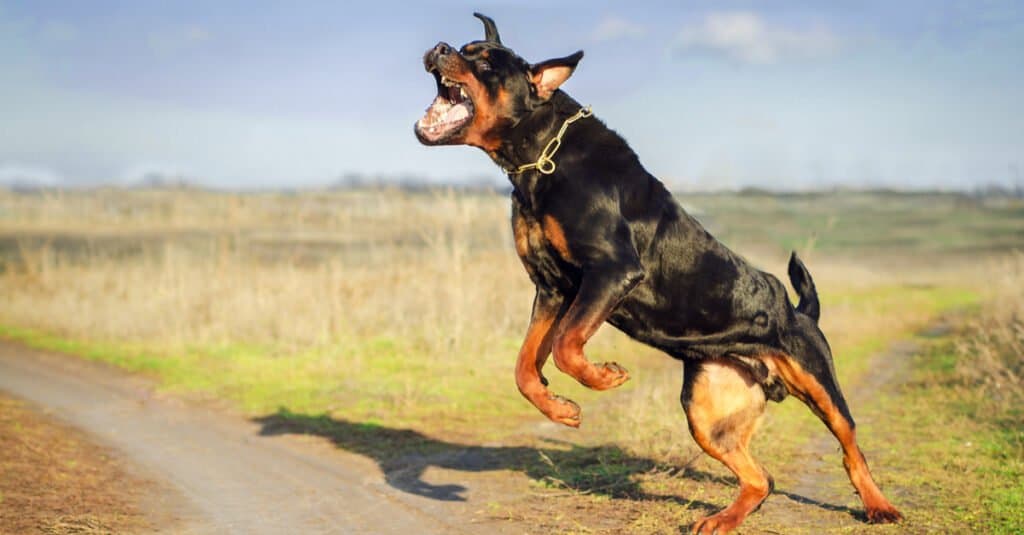
Roman Rottweilers are bred to be a bit larger than German Rottweilers and can develop more health issues.
©Olexandr Andreiko/Shutterstock.com
When it comes to size, the Roman Rottweiler is larger than the German Rottweiler. In terms of appearance, the German and Roman Rottweilers are very similar. However, because the Roman Rottweiler is not officially recognized as a breed, they get away with far more in terms of appearance. The coat colors of German Rottweilers are identical, but off-colors are not acknowledged as pure breeds.
Remember, whether you own either type of Rottweiler you should consider the best dog foods for Rottweilers to ensure the healthiest, happiest dog. It is important to consider dog food with a high level of protein to support their muscle mass, as well as supplements like Omega 3’s and 6’s to support coat and brain health.
Similar Dogs
When it comes to the physical characteristics of a Rottweiler, some other breeds that bear similar traits are the Dogue de Bordeaux, Boxer, and Bullmastiff. All three breeds share many of the same features, such as a large head with a broad muzzle and strong jaws. They both have a muscular body structure with a wide chest. And they each have short coats in solid colors like black or brown. However, each breed does have its own unique look. For example, Dogue de Bordeaux has wrinkles on its face, while Boxers typically have white markings around their eyes and muzzle.
Rottweilers are known for their loyal, protective, and confident personalities. While there is no other breed that precisely mirrors the temperament of a Rottweiler, there are some breeds with similar characteristics. The Doberman Pinscher is one such dog. They share many traits with Rottweilers in terms of intelligence, obedience, loyalty, and protectiveness. Both breeds also have a strong work ethic which makes them great family pets as well as working dogs.
The Giant Schnauzer is another breed that shares many qualities with the Rottie. They’re brave and obedient but can be stubborn at times too! Lastly, the Boxer has many similarities to the German or Roman Rottweiler when it comes to temperaments. Both breeds need firm handling but respond well to positive reinforcement training methods and make excellent guard dogs due to their size and strength.
How Do American Rottweilers Differ From Their German Ancestors?
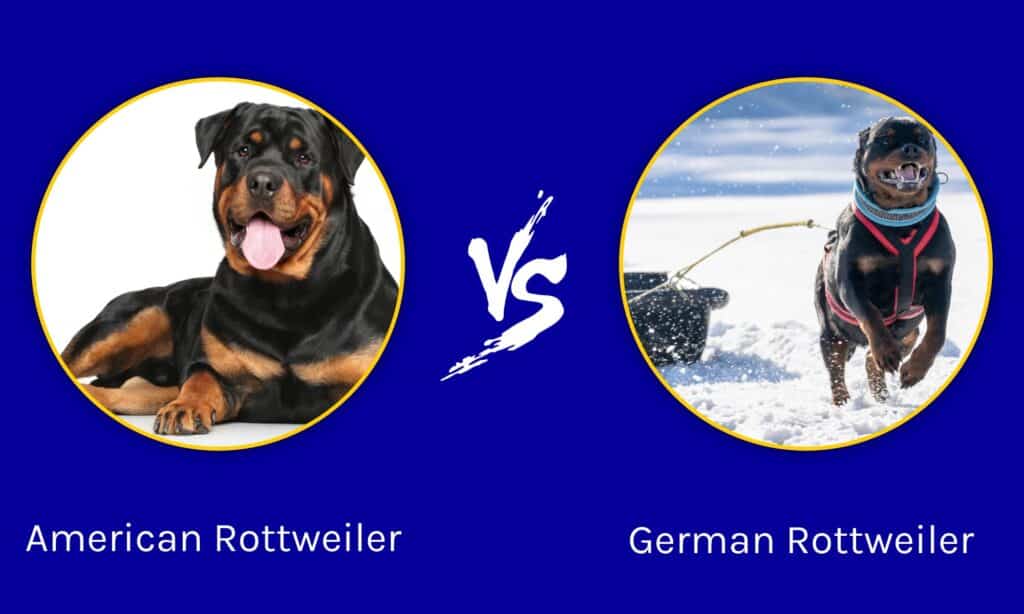
Primarily, American and German Rottweilers differ because of where they are bred. Because of this distinction, they do possess other minor differences as breeds. German Rottweilers are a bit more muscular and stocky than American Rottweilers, who in turn are leaner. While German Rotties have broader noses, almond-shaped eyes, triangular ears, and thicker necks, the American Rotties have smaller noses, a broader length between the ears on their heads, and can have longer hair.
Both breeds are loyal, calm, playful, and easygoing within their family dynamic. However, American Rotties can behave more reservedly around strangers and other animals and are more prone to be aggressive with dogs of the same sex. They do, however, respond well to training, though they also tend to be a bit more stubborn than German Rotties.
Summary of Roman Rottweiler vs. German Rottweiler
Here’s a recap of the eight key differences between these two breeds.
| Number | Category | Key Difference |
|---|---|---|
| 1 | Height | Roman Rottweilers are a bit taller than German Rottweilers. |
| 2 | Weight | While both have a maximum weight of 130 pounds for males, at 85-115 pounds female Roman Rottweilers are a bit heavier than German Rottweilers, which average 77-110 pounds. |
| 3 | Coat type | The undercoat is present on the neck and lower torso of a Roman Rottweiler, while the undercoat of a German Rottweiler is fully hidden beneath the topcoat. |
| 4 | Colors | There are many different shades of Roman Rottweilers available, but the German Rottweiler is usually only found in color combinations of Black/Mahogany, Black/Rust, and Black/Tan. |
| 5 | Temperament | Both have a lot of the same temperament characteristics of being protective, calm, sociable, intelligent, and watchful. |
| 6 | Trainability | German Rottweilers are some of the most intelligent and trainable dogs in the world and can be considered more easy to train than Roman Rottweilers. |
| 7 | Health Problems | As Roman Rottweilers are bred to be a bit larger than German Rottweilers, they can develop more health issues from joint issues including hip dysplasia. |
| 8 | Energy Levels | Roman Rottweiler have high energy levels and German Rottweilers have very high energy levels. |
The photo featured at the top of this post is © Jagodka/Shutterstock.com
Ready to discover the top 10 cutest dog breeds in the entire world?
How about the fastest dogs, the largest dogs and those that are -- quite frankly -- just the kindest dogs on the planet? Each day, AZ Animals sends out lists just like this to our thousands of email subscribers. And the best part? It's FREE. Join today by entering your email below.
Thank you for reading! Have some feedback for us? Contact the AZ Animals editorial team.







